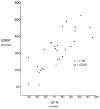Chronic renal homograft function: correlation with histology and lymphocyte antigen matching
- PMID: 4862761
- PMCID: PMC2965524
- DOI: 10.1016/0002-9343(67)90242-2
Chronic renal homograft function: correlation with histology and lymphocyte antigen matching
Abstract
Renal function was studied in twenty-nine of thirty-four surviving renal allograft recipients from an initial group of sixty-four patients two years after transplantation. Mean clearances of inulin and PAH were, respectively, greater than and equal to half the donors’ initial predicted clearances. Minimum urine osmolality during water diuresis was greater, and maximum urine osmolality during hydropenia was less than normal, an effect attributable partly to enhanced solute load in a single transplanted kidney.
Patients with compatible donor-recipient lymphocyte antigens demonstrated statistically better function than those with one or more incompatibilities, although there was a definite degree of overlap between the two groups. In contrast, little correlation could be demonstrated between the cumulative histopathology and renal clearances.
Renal function in patients with compatible donors was statistically greater than half the donors’ initial predicted function. Serial increase in renal clearances was documented in one patient with a compatible donor. Serial decreases were demonstrated in two patients with incompatible donors. These findings suggest that hypertrophy of the denervated, transplanted kidney occurs when immune reaction is minimal.
Figures








Similar articles
-
Acute renal response to large doses of intravenous prednisolone in kidney homograft recipients and in normal subjects.J Lab Clin Med. 1971 Jul;78(1):39-52. J Lab Clin Med. 1971. PMID: 4936366 Free PMC article. Clinical Trial.
-
Chronic survival after human renal homotransplantation. Lymphocyte-antigen matching, pathology and influence of thymectomy.Ann Surg. 1965 Oct;162(4):749-87. doi: 10.1097/00000658-196510000-00016. Ann Surg. 1965. PMID: 5319400 Free PMC article. No abstract available.
-
Serial hemodynamics after renal allotransplantation in man.Circulation. 1970 Feb;41(2):217-24. doi: 10.1161/01.cir.41.2.217. Circulation. 1970. PMID: 4904940 No abstract available.
-
Immunology of transplantation.Tex Med. 1970 May;66(5):48-53. Tex Med. 1970. PMID: 4913546 Review. No abstract available.
-
Current status of leukocyte matching in clinical homotransplantation.Can Med Assoc J. 1970 May 30;102(11):1181-2 passim. Can Med Assoc J. 1970. PMID: 4911962 Free PMC article. Review. No abstract available.
Cited by
-
Changes in leucocyte migration after renal transplantation.Br Med J. 1969 Nov 1;4(5678):275-8. doi: 10.1136/bmj.4.5678.275. Br Med J. 1969. PMID: 4899455 Free PMC article.
-
Blood flow in kidney transplants: studies at exploration of a previously transplanted kidney, with special reference to rejection.Ann Surg. 1968 Nov;168(5):803-9. doi: 10.1097/00000658-196811000-00003. Ann Surg. 1968. PMID: 4879201 Free PMC article. No abstract available.
-
Long-term survival after renal transplantation in humans: (with special reference to histocompatibility matching, thymectomy, homograft glomerulonephritis, heterologous ALG , AND RECIPIENT MALIGNANCY).Ann Surg. 1970 Sep;172(3):437-72. doi: 10.1097/00000658-197009000-00011. Ann Surg. 1970. PMID: 4918003 Free PMC article. No abstract available.
-
Human renal transplants. 3. Immunopathologic studies.Lab Invest. 1970 Jun;22(6):588-604. Lab Invest. 1970. PMID: 4914381 Free PMC article.
-
Thymectomy and renal homotransplantation.Clin Exp Immunol. 1970 Jun;6(6):803-14. Clin Exp Immunol. 1970. PMID: 4920548 Free PMC article.
References
-
- Murray JE, Gleason R, Bartholomay A. Fourth report of the human kidney transplant registry. Transplantation. 1965;3:684. - PubMed
-
- Starzl TE. Experience in Renal Transplantation. Philadelphia: W. B. Saunders Co; 1964.
MeSH terms
Substances
Grants and funding
LinkOut - more resources
Full Text Sources

